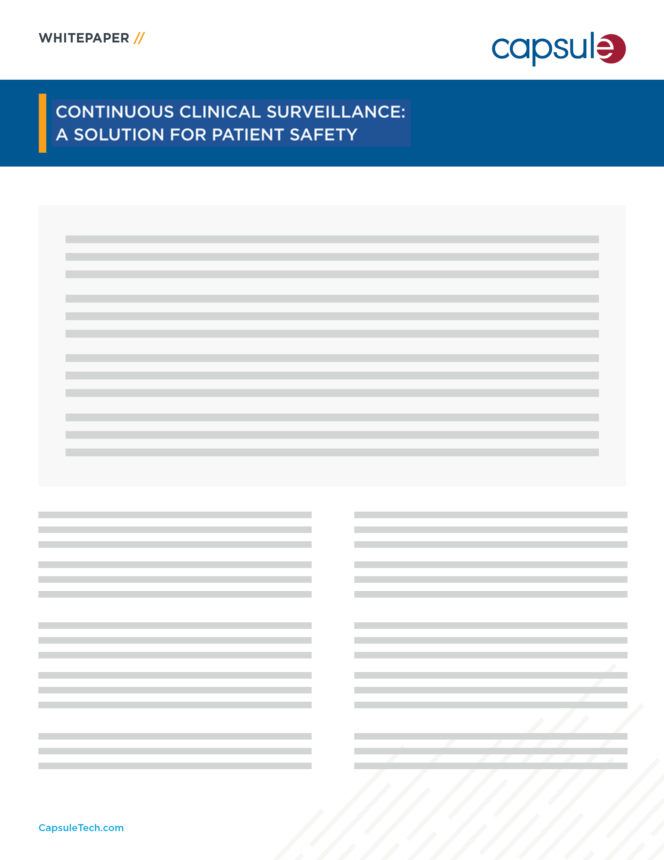Medical Device Data Analytics
The value of clinical information is expanding with the emergence of “Big Data”, data mining, artificial intelligence, machine learning, data driven insights, and much more. Still, research indicates that “more than 80% of medical information remains unstructured and hard to process.”[1] Given the enormous data lakes that support multi-facility healthcare organizations, this statistic of 80% is not surprising. In an interrupt-driven work environment, where patient care, documentation, and, to a lesser degree, clinical research direct the time and effort of the patient care team, clinicians often do not have the time to query, retrieve, and analyze retrospective data for prospective insights. Yet, with a stronger focus on personalized medicine and telehealth, care providers are in need of ways to easily mine and search real-time data without the added headache of structuring and pulling all the information together. How does the healthcare organization devote resources to these goals and, moreover, where do they start?
Capsule Technologies can serve as nexus to liberating continuous live-streaming medical device data for aggregation into a centralized easily accessible web-based solution. This solution, known as Reporting and Analytics, provides several tools for assessment of the measurements and alarms collected by the medical devices. In partnering with Capsule, healthcare organizations can focus on evidence-based and personalized care facilitated by Reporting and Analytics’ visualizations, dashboards, and reports of moment-by-moment current and historic patient state.
RELATED READING: Making the Complex Simple with a Data Analytics Solution for Investigating Real-time Medical Device Data (2)
Partners in Data Transformation
Healthy People 2030 identifies several plans of action and, among them, they indicate “provide accurate, timely and accessible data that can drive targeted actions to address regions and populations that have poor health and are at risk of poor health.”[2] Many solutions are available in the market that address the analytics of business operations to achieve cost-effective care through insights into admittance rates, post-discharge mortality, equipment shortages, etc. A few examples include Allscripts’ Practice Analytics, Atlyerx’s Healthcare Analytics Starter Kit, or LeanTaaS’s iQueue.[3, 4, 5] Some solutions aim to improve population health outcomes by employing risk scoring predictive models like Biofourmis’ Biovitals, or Optum’s OptumIQ.[6, 7] Few solutions, however, delve into the clinical applications of the data with regards to real-time operational use at the bedside for immediate assessment or predictions using medical device alarms and physiologic measurements. The formerly identified clinical analytics offerings are typically limited to retrospective de-identified clinical research datasets or EHR enterprise level data as is the case with Veradigm’s Evalytica and Cerner’s HealtheAnalytics.[8, 9] These commercial analytics solutions typically lack source linkage to the medical devices themselves for live collection and, therefore, are limited to descriptive analytics, using historic data to understand current outcomes.[10] What about the continuous live-streaming medical device data?
Accurate. Timely. Accessible. These are the key tenets of Healthy People 2030. Historically, clinical data analytics solutions have been concerned with cancer treatment, adverse drug events and clinical trials, all of which utilize retrospective data sets. Capsule’s data Reporting and Analytics approach allows for both retrospective and real-time investigation of medical device data, inclusive of both alarms and parameter trends. Continuous real-time data presents insights, generally absent of gaps in information, with a frequency ranging from sub-second to seconds. When combined with retrospective data, the real-time data enables assessment of current state (where the patient is), and prior state (past vital signs history, adverse events, where the patient was) to facilitate a prediction of future state (where the patient is going). With both archived and new information at their disposal, clinicians have more accurate insights as to what is presently happening with their patient informed by historic and current events in the patient’s plan of care, as well. Subsequently, the care team can utilize these robust real-time data as definitive evidence in support of treatment plans and guidelines. The accumulation of real-time medical device data in support of validation of patient condition by the caregivers can further serve in the development of predictive models that enhance the timeliness of clinician notifications regarding adverse events as well as in adjustments to care delivery.
Hence, a key benefit of continuous live-streaming medical device data, facilitated by the Capsule Medical Device Information Platform (MDIP), is that the patient care team, whether present locally at the bedside or remote, can monitor the patient for signs of change or deterioration. The Reporting and Analytics approach employs a software application accessed and managed through a Web-based user interface. This application provides rapid access to regularly updated reports and visuals for complete data capture and retrieval. Clinicians can customize and develop their own reports, apply mathematical methods to perform “what-if” assessments on the data, and can download data or re-direct to other repositories in support of operational use, research, quality assessments, and departmental or alarm committee evaluations.
Watch for the next installment in this series on making the complex simple with Reporting and Analytics!
About the author
Jessica Serrao is a clinical informatics data scientist and John Zaleski, Ph.D., NREMT, CAP, CPHIMS is head of clinical informatics at Capsule Technologies.
Read more about clinical surveillance in critical care to learn how Smart Alerts can be utilized.
Download